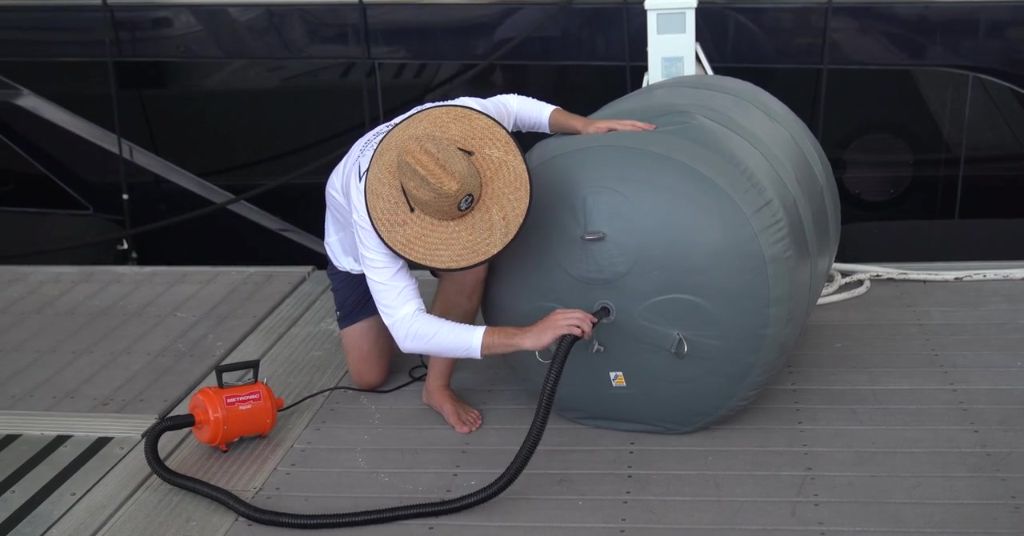Fenders are essential for protecting your vessel from damage, whether you’re docking in a busy marina or mooring at an unfamiliar port. However, even the best fenders must be properly inflated to perform effectively. Improper inflation can lead to reduced protection, increased wear and tear on the fender, and potential damage to your vessel. In this guide, AERÉ Marine outlines the proper way to inflate your fenders, ensuring they offer maximum protection for your boat.
Why Proper Fender Inflation Matters
Correct fender inflation is crucial for absorbing impact and cushioning your vessel. An over-inflated fender becomes too rigid, reducing its ability to compress and absorb shock, which can increase the risk of damage to the fender, your vessel, or the dock over time. Conversely, an under-inflated fender may be too soft to adequately cushion the vessel, reducing its effectiveness and potentially allowing contact with the dock or another vessel.
A properly inflated fender strikes the perfect balance: it is flexible enough to absorb energy from impacts, yet firm enough to maintain its shape and provide effective protection.
The Ideal Pressure: How Much Should You Inflate?
AERÉ Marine inflatable fenders are designed for durability and effective protection, but achieving the right inflation level is key. Here’s how to gauge the proper inflation level:
- Pressure Range: Inflate AERÉ Marine inflatable fenders to a pressure of 1.8 to 2.2 PSI (pounds per square inch). This is the ideal pressure range for optimal performance.
- Touch Test: When you press the side of the inflated fender, it should feel firm yet yield slightly to the pressure of your hand. It shouldn’t be rock hard or too soft to press inward.
You can use a hand-held air pump or a compressor with a pressure gauge to reach the correct PSI. Be sure to monitor the pressure and adjust as needed.
Step-by-Step Instructions for Proper Fender Inflation
Follow these steps to guarantee your AERÉ Marine fenders are correctly inflated and ready to protect your vessel:
1. Gather the Right Tools
- Air pump or compressor: Choose an air pump with a nozzle that fits your fender valve. For larger fenders, you can use a compressor, but be careful not to over-inflate.
- Pressure gauge: A pressure gauge is essential for making sure you reach the optimal PSI without over-inflating.
- Valve adaptor (if needed): Some fenders may require a specific valve adaptor to assure a proper fit for the inflation nozzle.
2. Check the Valve and Deflate (if Necessary)
Before inflating the fender, inspect the valve to confirm it’s clean and free from debris. If you’re re-inflating a fender or adjusting its pressure, gently press the valve stem to release any remaining air.
3. Attach the Pump or Compressor
Fit the pump or compressor nozzle to the valve, securing a tight connection to prevent air leaks. Begin inflating the fender slowly.
4. Monitor the Pressure
As you inflate the fender, use your pressure gauge to monitor the air pressure. Make sure the fender reaches the recommended 1.8 to 2.2 PSI. If using a compressor, inflate slowly to avoid accidentally over-inflating.
5. Check for Proper Inflation
Once inflated, press the side of the fender with your hand. It should feel firm yet slightly pliable, indicating it has the right amount of air to absorb impacts while maintaining its shape.
6. Close the Valve Securely
After reaching the proper pressure, remove the pump or compressor and quickly close the valve by tightening the cap securely. Confirm the valve is completely sealed to prevent air leakage.
Common Mistakes to Avoid
- Over-Inflation: Do not exceed 2.2 PSI. Over-inflated fenders become too rigid and may not absorb impacts properly, increasing the risk of damage to both the fender and your vessel over time.
- Under-Inflation: Under-inflated fenders may not provide adequate protection. They may sag, become soft, and fail to cushion the vessel effectively during docking.
- Inconsistent Inflation: Regularly check the inflation levels of your fenders, especially if your vessel is in long-term storage or if you use the fenders seasonally. Temperature changes, particularly in colder climates, can affect air pressure, causing your fenders to lose air over time.
Maintenance Tips for Inflatable Fenders
Proper maintenance will help extend the life of your fenders and ensure they effectively protect your vessel:
- Check Pressure Regularly: Monitor the air pressure in your fenders at least once a month, or more frequently if you’re in varying climates or using your vessel often.
- Clean After Use: After docking—especially in saltwater—rinse your fenders with fresh water to remove salt and debris that can degrade the material over time.
- Store Properly: If you’re storing your vessel for the season or not using it for an extended period, deflate the fenders slightly to relieve pressure and store them in a cool, dry place to prevent material degradation.
- Inspect for Wear: Regularly inspect your fenders for signs of wear or damage. Look for abrasions, leaks, or weakened seams that could affect performance. If you notice any damage, repair it promptly to prevent further issues.
Why Choose AERÉ Marine Inflatable Fenders?
At AERÉ Marine, we design our inflatable fenders for top-of-the-line protection and durability. Manufactured with heavy-duty, marine-grade materials, our fenders are built to withstand harsh marine environments while remaining lightweight and easy to use. We offer custom sizes and features, such as our Fenda-Sox covers for added protection and style, ensuring our products are tailored to fit your vessel’s specific needs.
When properly inflated and maintained, AERÉ Marine fenders protect your vessel from docking mishaps, rough weather, and other hazards, allowing you to enjoy your time on the water with peace of mind.
Conclusion
Proper fender inflation is essential for protecting your vessel while docking or mooring. By following AERÉ Marine’s guidelines, you can maximize the performance of your inflatable fenders and extend their lifespan. Whether you’re a seasoned boater or new to the marine world, making sure your fenders are correctly inflated is a simple yet vital step in safeguarding your vessel.









